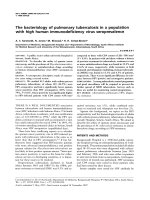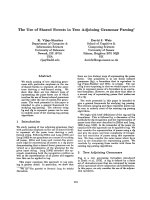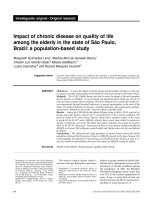The Art of Grief The Use of Expressive Arts in a Grief Support Group pptx
Bạn đang xem bản rút gọn của tài liệu. Xem và tải ngay bản đầy đủ của tài liệu tại đây (5.48 MB, 324 trang )
The Art of Grief
RT55351.indb 1 4/30/07 9:12:55 AM
The Series in Death, Dying, and Bereavement
Robert A. Neimeyer, Consulting Editor
Beder — Voices of Bereavement: A Casebook for Grief Counselors
Berger — Music of the Soul: Composing Life Out of Loss
Davies — Shadows in the Sun: The Experiences of Sibling Bereavement in Childhood
Harvey — Perspectives on Loss: A Sourcebook
Katz & Johnson — When Professionals Weep: Emotional and Countertransference Responses in End-
of-Life Care
Klass — The Spiritual Lives of Bereaved Parents
Jeffreys — Helping Grieving People — When Tears Are Not Enough: A Handbook for Care Providers
Leenaars — Lives and Deaths: Selections from the Works of Edwin S. Shneidman
Lester — Katie’s Diary: Unlocking the Mystery of a Suicide
Martin & Doka — Men Don’t Cry … Women Do: Transcending Gender Stereotypes of Grief
Nord — Multiple AIDS-Related Loss: A Handbook for Understanding and Surviving a Perpetual Fall
Roos — Chronic Sorrow: A Living Loss
Rogers — The Art of Grief: The Use of Expressive Arts in a Grief Support Group
Rosenblatt — Parent Grief: Narratives of Loss and Relationship
Rosenblatt & Wallace — African-American Grief
Tedeschi & Calhoun — Helping Bereaved Parents: A Clinician’s Guide
Silverman — Widow to Widow, Second Edition
Werth — Contemporary Perspectives on Rational Suicide
Formerly The Series in Death Education, Aging, and Health Care
Hannelore Wass, Consulting Editor
Bard — Medical Ethics in Practice
Benoliel — Death Education for the Health Professional
Bertman — Facing Death: Images, Insights, and Interventions
Brammer — How to Cope with Life Transitions: The Challenge of Personal Change
Cleiren — Bereavement and Adaptation: A Comparative Study of the Aftermath of Death
Corless & Pittman-Lindeman — AIDS: Principles, Practices, and Politics, Abridged Edition
Corless & Pittman-Lindeman — AIDS: Principles, Practices, and Politics, Reference Edition
Curran — Adolescent Suicidal Behavior
Davidson — The Hospice: Development and Administration, Second Edition
Davidson & Linnolla — Risk Factors in Youth Suicide
Degner & Beaton — Life-Death Decisions in Health Care
Doka — AIDS, Fear, and Society: Challenging the Dreaded Disease
Doty — Communication and Assertion Skills for Older Persons
Epting & Neimeyer — Personal Meanings of Death: Applications for Personal Construct Theory to
Clinical Practice
Haber — Health Care for an Aging Society: Cost-Conscious Community Care and Self-Care Approaches
Hughes — Bereavement and Support: Healing in a Group Environment
Irish, Lundquist, Nelsen — Ethnic Variations in Dying, Death, and Grief: Diversity in Universality
Klass, Silverman, Nickman — Continuing Bonds: New Understanding of Grief
Lair — Counseling the Terminally Ill: Sharing the Journey
Leenaars, Maltsberger, Neimeyer — Treatment of Suicidal People
Leenaars & Wenckstern — Suicide Prevention in Schools
Leng — Psychological Care in Old Age
Leviton — Horrendous Death, Health, and Well-Being
Leviton — Horrendous Death and Health: Toward Action
Lindeman, Corby, Downing, Sanborn — Alzheimer’s Day Care: A Basic Guide
Lund — Older Bereaved Spouses: Research with Practical Applications
Neimeyer — Death Anxiety Handbook: Research, Instrumentation, and Application
Papadatou & Papadatos — Children and Death
Prunkl & Berry — Death Week: Exploring the Dying Process
Ricker & Myers — Retirement Counseling: A Practical Guide for Action
RT55351.indb 2 4/30/07 9:12:56 AM
Samarel — Caring for Life and Death
Sherron & Lumsden — Introduction to Educational Gerontology, Third Edition
Stillion — Death and Sexes: An Examination of Differential Longevity Attitudes, Behaviors, and
Coping Skills
Stillion, McDowell, May — Suicide Across the Life Span — Premature Exits
Vachon — Occupational Stress in the Care of the Critically Ill, the Dying, and the Bereaved
Wass & Corr — Childhood and Death
Wass & Corr — Helping Children Cope with Death: Guidelines and Resources, Second Edition
Wass, Corr, Pacholski, Forfar — Death Education II: An Annotated Resource Guide
Wass & Neimeyer — Dying: Facing the Facts, Third Edition
Weenolsen — Transcendence of Loss Over the Life Span
Werth — Rational Suicide? Implications for Mental Health Professionals
RT55351.indb 3 4/30/07 9:12:56 AM
RT55351.indb 4 4/30/07 9:12:56 AM
The Art of Grief
The Use of Expressive Arts in a
Grief Support Group
edited by J. Earl Rogers
RT55351.indb 5 4/30/07 9:12:56 AM
Routledge
Taylor & Francis Group
270 Madison Avenue
New York, NY 10016
Routledge
Taylor & Francis Group
2 Park Square
Milton Park, Abingdon
Oxon OX14 4RN
© 2007 by Taylor & Francis Group, LLC
Routledge is an imprint of Taylor & Francis Group, an Informa business
Printed in the United States of America on acid‑free paper
10 9 8 7 6 5 4 3 2 1
International Standard Book Number‑13: 978‑0‑415‑95535‑5 (Softcover)
No part of this book may be reprinted, reproduced, transmitted, or utilized in any form by any electronic,
mechanical, or other means, now known or hereafter invented, including photocopying, microfilming,
and recording, or in any information storage or retrieval system, without written permission from the
publishers.
Trademark Notice: Product or corporate names may be trademarks or registered trademarks, and are
used only for identification and explanation without intent to infringe.
Library of Congress Cataloging‑in‑Publication Data
The art of grief : the use of expressive arts in a grief support group / [compiled by J.
Earl Rogers].
p. cm. ‑‑ (The series in death, dying, and bereavement)
Includes bibliographical references.
ISBN 0‑415‑95535‑1 (softcover)
1. Grief. 2. Bereavement‑‑Psychological aspects. 3. Arts‑‑Therapeutic use. I.
Rogers, J. Earl.
BF575.G7A77 2007
155.9’37‑‑dc22 2006039080
Visit the Taylor & Francis Web site at
and the Routledge Web site at
We gratefully acknowledge the following contributors for granting permission to include their material
in this book:
Ina Albert, Penny Allport, Sara Baker, Sandra Baughman, Nicole Burgess, Lauren B. Chandler, Janet Feld‑
man, Laura Kiser, Judith Koeleman, Deborah Koff‑Chapin, Carol McIntyre, Carole M. McNamee, Debra
Mier, Hernando A. Mispireta, Thomas D. Moore, J. Earl Rogers, Janet Shaw Rogers, Sara Spaulding Phil‑
lips, Laura Thomae, Sandra M. Walsh, and Lisa Wayman
RT55351.indb 6 4/30/07 9:12:56 AM
Dedication
To my wife, Janet
Thank you for all your support, love, and hard work
My mirror
âme et esprit unis
RT55351.indb 7 4/30/07 9:12:56 AM
RT55351.indb 8 4/30/07 9:12:56 AM
ix
CONTENTS
About the Author/Editor xiii
Contributors xv
Series Editor’s Foreword xvii
Acknowledgments xxi
SECTION I THE USE OF EXPRESSIVE ARTS IN
A GRIEF SUPPORT GROUP
Chapter 1 Introduction 3
J. Earl Rogers
Chapter 2 Leading Grief Support Groups 9
J. Earl Rogers
Chapter 3 Basics of Grief and Loss 21
J. Earl Rogers
Chapter 4 Children and Teens 31
J. Earl Rogers
Chapter 5 How to Use This Book 39
J. Earl Rogers
SECTION II THE GRIEF SUPPORT GROUP
CURRICULUM: EIGHT SESSIONS
Chapter 6 Session 1: The Storytellers — Oral History and
Introduction 49
J. Earl Rogers
RT55351.indb 9 4/30/07 9:12:56 AM
x Contents
Chapter 7 Session 2: The Written Story — Creative Writing,
Journaling, and Poetry 59
J. Earl Rogers
Chapter 8 Session 3: Sandtray — An Accessible Strategy
for the Grief Process 69
J. Earl Rogers
Chapter 9 Session 4: The Body of Grief 81
J. Earl Rogers
Chapter 10 Session 5: The Art of Collage — Visions and Images 95
J. Earl Rogers
Chapter 11 Session 6: The Music 101
Nicole Burgess
Chapter 12 Session 7: Drama and Theater 115
Lauren B. Chandler
Chapter 13 Session 8: Grief and the Sacred Art of Ritual 129
Janet Shaw Rogers
SECTION III ALTERNATIVE ART FORMS,
PROGRAMS, AND STORIES
OF ART AND HEALING
Chapter 14 The Painters 153
Deborah Koff-Chapin, Carol McIntyre,
and Judith Koeleman
Chapter 15 The Writers 189
Sara Baker and Sara Spaulding-Phillips
Chapter 16 Programs in Art 199
Debra Mier, Laura Thomae, and Carole M. McNamee
Chapter 17 Programs for Teens and Children 227
Sandra Baughman and Laura Kiser
Chapter 18 Alternative Art Forms 239
J. Earl Rogers and Janet Feldman
Chapter 19 Stories of Art, Grief, and Healing 259
Thomas D. Moore, Sandra M. Walsh, Lisa Wayman, and
Penny Allport
RT55351.indb 10 4/30/07 9:12:57 AM
Contents xi
Chapter 20 Conclusion 281
J. Earl Rogers
References 287
Index 293
RT55351.indb 11 4/30/07 9:12:57 AM
RT55351.indb 12 4/30/07 9:12:57 AM
xiii
ABOUT THE AUTHOR/EDITOR
J. Earl Rogers, JD, PsyD, CT, is an artist and senior clinical consultant at
Comox Valley Hospice on Vancouver Island where he practices as a certi-
ed thanatologist and end-of-life counselor. Dr. Rogers also maintains a
private counseling practice in Courtenay, British Columbia. He has served
on the board of directors of the Association of Death Education and Coun-
seling (ADEC) and is a member of the Society for Arts in Healthcare and
several prominent U.S. and Canadian hospice associations. He has 30
years experience as a civil trial attorney, 5 years as a U.S. naval pilot, and
has published in several legal journals regarding stress and the law.
RT55351.indb 13 4/30/07 9:12:57 AM
RT55351.indb 14 4/30/07 9:12:57 AM
xv
CONTRIBUTORS
Ina Albert
Ina Albert Associates, LLC
Whitesh, Montana
Penny Allport
Swara Inspiritations
Richmond, British Columbia
Sara Baker, MA
Loran Smith Center for Cancer
Support
Athens, Georgia
Sandra Baughman
Arts for the Spirit Coordinator
Oakwood Healthcare System
Northville, Michigan
Nicole Burgess, Bmus, BMT, MTA
Music Therapist
Comox, British Columbia
Lauren B. Chandler, BA, MSW
Consultant and Social Worker
Dougy Center for Grieving
Children and Families
Portland, Oregon
Janet Feldman
Act ALIVE
Barrington, Rhode Island
Laura Kiser, MA, ATR, LCPC
The Children’s Hospital at
Monteore
Bronx, New York
Judith Koeleman
Artist
Campbell River, British Columbia
Deborah Koff-Chapin
Center for Touch Drawing
Langley, Washington
Carol McIntyre, MA
The Painting Place
Santa Rosa, California
Carol M. McNamee, PhD
Director, The Arts in Healthcare
Project
The Family Therapy Center of
Virginia Tech
Blacksburg, Virginia
Debra Mier, RDT, LCSW
Willow House
Northbrook, Illinois
Hernando Mispireta
Nurse
South Miami Hospital
Miami, Florida
RT55351.indb 15 4/30/07 9:12:57 AM
xvi Contributors
Thomas D. Moore
Violin Professor, New World
School of the Arts
Miami, Florida
Janet Shaw Rogers
Artist
Shaw Rogers Consulting, Women
in Business
Courtenay, British Columbia
Sara Spaulding-Phillips, MA
Psychotherapist
Santa Rosa, California
Laura Thomae, Mt-BC
Coordinator of Therapeutic Arts
Keystone Hospice
Wyndmoor, Pennsylvania
Sandra M. Walsh, RN, PhD
Professor, Barry University School
of Nursing
Miami Shores, Florida
Lisa Wayman, RN, MSN
Nurse and Artist
Phoenix, Arizona
RT55351.indb 16 4/30/07 9:12:57 AM
xvii
SERIES EDITOR’S FOREWORD
It was Bertha Pappenheim — the famous “Anna O.” of Josef Breuer’s rst
experiments with psychoanalysis, and a pioneer social worker in her own
right — who rst named psychotherapy “the talking cure.” And so it is, as
a legion of well-controlled studies documents. Across a surprising variety
of psychotherapeutic approaches, verbal exchanges between client and
therapist can be powerfully curative — except when they aren’t. And when
they aren’t, when the resources of literal speech alone are not enough,
people often nd themselves reaching for other symbolic resources to
express, share, and transform wordless suffering into something that can
be borne, validated, even cherished as a source of growth.
Grief often occasions just such a search for meaning, and the expressive
arts provide a rich panoply of possibilities for its further processing. It is
this insight that has stimulated a remarkably broad-ranging exploration
of artistic activities of all kinds in healthcare contexts, ranging from paint-
ing classes for seriously ill children to journaling workshops for breast
cancer survivors. And it is this same recognition that has led Earl “Tio”
Rogers to spend a professional lifetime delving deeply into these many
traditions, seeking their relevance for bereavement support groups, as
well as for his own life. Indeed, it is this “leveling of the playing eld”
— bridging activities that proved personally healing into teachable skills
that can benet others — that accounts for the genuineness of each of the
many contributions to this volume. For group leaders and members alike,
immersion in and reection on performance, music, bodywork, painting,
or creative writing offer the prospect of moving beyond grief to growth,
beyond trauma to transformation.
A clear strength of this book is its remarkable comprehensiveness. Vir-
tually every medium of artistic expression seems to be represented, nearly
every vein of creativity mined for its healing potential. The engaged reader
will accompany Rogers week by week through a systematic curriculum
rened in the crucible of his own bereavement support group experi-
ence, as participants are gently encouraged to create a space for telling the
RT55351.indb 17 4/30/07 9:12:58 AM
xviii Series Editor’s Foreword
story of their loss, to themselves in a journal, and to caring others in the
safety of the group; to deepen their engagement with its plot and themes
through creative writing; to give it symbolic expression using sandtray;
to embody it in physical movement; to assemble it in the evocative imag-
ery of collage; to make it audible in music; to perform it in drama; and
to give it sacred validation in ritual. In chapters devoted to each of these
topics, Rogers distills the essence of his decades of engagement with each
expressive tradition to offer concrete advice and instructions for the use
of each artistic medium, for children, teens, and adults. Although, as he
repeatedly cautions, the resulting curriculum is no substitute for training
in formal art therapy tailored to the needs of complex individual cases, it
certainly offers an adaptable structure for grief support in a wide variety
of settings, ranging from bereavement programs sponsored by hospices
to similar services for patients and their families in medical settings.
A second winning feature of this book is its attention to “voices in the
eld” — a dozen minichapters from practitioners of a rainbow of expres-
sive arts summarizing their methods and their impact, often sharing their
own stories, as well as those of their group members to convey their heal-
ing potential. Here I found myself engaged in both familiar and novel
practices: the poignancy of poetry, the strange allure of Touch Drawing,
the power of performance, the mystery of mask making, and much more.
In addition, these chapters conveyed the creative integration of multiple
methods in programs that specialize in particular populations (children,
teens) and problems (cancer, HIV/AIDS). Completing this section, readers
will be moved to explore the relevance of these expressive traditions for not
only their group members or patients, but also for their own self-care.
In closing, in writing and editing this book, Rogers opens a door to an
expanded practice of bereavement support, one that at the same time taps
the wellsprings of individual creativity and mobilizes the validation and
inspiration of a caring group. Along with other recent books in the Rout-
ledge Series on Death, Dying, and Bereavement such as Joy Berger’s Music
of the Soul, Shep Jeffreys’s Helping Grieving People, and Phyllis Silverman’s
Widow-to-Widow, Earl “Tio” Rogers’s The Art of Grief offers practical guid-
ance for professional therapists and bereavement support providers alike
in implementing services that harvest the healing potential of both sym-
bolic talk and action. As a tribute to the efforts of Rogers and his artistic
contributors, it feels tting to conclude with a brief poem I have penned
that acknowledges their courage — a courage shared by the reader — to
enter the heart of grief and loss to accompany those they serve on their
travel through loss to gain. In these pages the reader should nd good
companionship on that journey.
RT55351.indb 18 4/30/07 9:12:58 AM
Series Editor’s Foreword xix
Travelers
© 2006, Robert A. Neimeyer
You know the lucky thing about my hip replacement?
she asked, not waiting for the answer.
It made me think about advance directives,
my living will, how I’d like to die.
Yeah, he said, her colleague
who chatted amiably with death
each day, like two old men
playing checkers in the park.
I know what you mean.
This is how it is
with the nurses, doctors, therapists
who walk down the halls of dying
as through the home of a relative,
pausing to leaf through the Geographic,
or straighten a family photograph on the wall.
They have earned their ease
the hard way,
learned to reach through the bramble
to nd the fruit, add weight
to the rusty pail.
They have not so much grown inured
to pain as they have learned to savor it,
taste the sweetness in the grapefruit’s bite,
feel the glow of a day’s hard toil.
In the end, we need them
as we need seasoned travelers
met in an unfamiliar land.
They greet us on the steep trail,
in the twisting streets, point the way
to a good taverna, trace the path home.
Most of all, they help us
parse the dark syllables in our hearts,
bare them,
and seek cleansing
in the gathering storm.
Robert A. Neimeyer, PhD
The University of Memphis
Series Editor
RT55351.indb 19 4/30/07 9:12:58 AM
RT55351.indb 20 4/30/07 9:12:58 AM
xxi
ACKNOWLEDGMENTS
Where does one begin to acknowledge all those who have made this, or
any other book, happen? To name anyone is to exclude someone impor-
tant. With that risk, however, I want to acknowledge some of the people
who supported and contributed to the completion of this book. If I have
not mentioned someone, know that your contribution was as important as
everyone who was mentioned. Thank you.
First to my wife, Janet, for moral support, editing, and proofreading,
and her wonderful chapter on “Grief and the Sacred Art of Ritual.” My
children, Joseph and Devora, busy in their own careers, who listened and
urged me on when I was sure that I could not write another word. To
the curriculum chapter writers, Lauren and Nicole, thank you for your
work and your timeliness. For all the friends who cheered me on and read
drafts and applauded each little step along the way.
The depth and richness of this book is largely due to the contributors
who offered their art, their stories, and their programs using art for heal-
ing. Art is a personal process and sacred to each of us who attempt to share
our creative process with others. While art can be a solitary activity, it is
in the group setting that deep healing can occur. You will see that healing
process in the stories shared in Part III of the book. Thank you each one of
you, for your willingness to share, your openness in telling the stories, and
your creative spirit: Deborah Koff-Chapin, Carol McIntyre, Judith Koel-
eman, Sara Baker, Sara Spaulding-Phillips, Debra Mier, Laura Thomae,
Carol McNamee, Sandra Baughman, Laura Kiser, Janet Feldman, Tio (the
alter ego), Sandra Walsh, Thomas D. Moore, Penny Allport, Lisa M. Way-
man, Ina Albert, and Hernando A. Mispireta. Thanks to Alex and Kath-
leen for sharing their story of the loss of their daughter and the wonderful
photographs of the rituals they used to help in the healing process.
Many of the contributors belong to the Society for Arts in Healthcare,
and answered my call for stories about the use of art in groups and grief.
What a wonderful forum for artists and healthcare professionals to share
their work and teachings.
RT55351.indb 21 4/30/07 9:12:58 AM
xxii Acknowledgments
Bob Baugher introduced me to The Association of Death Education
and Counseling (ADEC), and gave me a list of books to read, so many
years ago. To all the members, friends, and colleagues of ADEC who sup-
ported, taught, and mentored me; especially, Robert Neimeyer, Tom Attig,
Dick Gilbert, Linda Goldman, Donna Schuurman, Lynne DeSpelder, Lu
Redmond, Delpha Camp, Ron Barrett, Alan Wolfelt, and the members of
the Board of Directors with whom I was honored to serve. To every author
and researcher upon whose shoulders I stand, thank you for your efforts
to increase our knowledge of thanatology.
This book was a small concept based on work done with Sharon Lukert
at the Zen Hospice End-of-Life Counselor training (now Metta Institute),
when Dana Bliss, Behavioral Sciences Editor at Routledge, walked up at
an ADEC conference and asked if I could turn the concept into a book.
Thank you Dana, and all your staff, for seeing the merit in the concept of
using art in a grief support group and supporting me through the process.
Final edits and preparation of the resource list was done by Arran Sher-
bourne of Courtenay, British Columbia. The photographs in the chapter
on movement were done by our friend Donna Dow also of Courtenay.
I work at a wonderful hospice in the Comox Valley on Vancouver Island
with fantastic volunteers and a wonderful staff: Terri, the executive direc-
tor; Monique, our administrative assistant (without whom no work would
get done); Christy, our volunteer coordinator; Karen our grief counsellor;
and the volunteer grief counsellors. It is a pleasure working with these
people. They teach me every day the lessons of compassion and service.
I have been fortunate to have many wonderful teachers on my path
whom have shared their knowledge, compassion, and experience: Robert
Strock who started me on this path of being with dying, Joan Halifax of
Upaya Foundation of Santa Fe, who has guided so many health care pro-
fessionals to just “Be with the dying,” Richard Moss, although no longer
in my life, has been a great inspiration, Frank Ostaseski, and the teach-
ers and fellow students with the Alaya Institute End-of-Life Practitioner
training in Marin, California. Thank you all.
J. Earl Rogers, JD, PsyD, CT
RT55351.indb 22 4/30/07 9:12:58 AM
I
S e c t i o n
The Use of Expressive Arts
in a Grief Support Group
RT55351.indb 1 4/30/07 7:06:29 AM
RT55351.indb 2 4/30/07 7:06:29 AM









